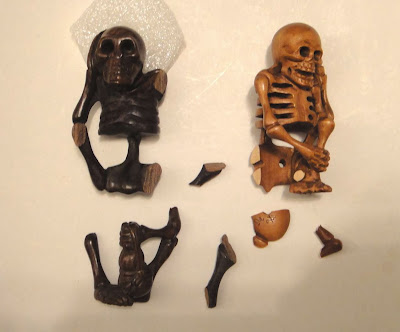Tonight, October 31, 2013 at about 8:00 p.m., there was a
sizable earthquake in Taipei. I was working at my desk when I felt the first
tremors. It quickly got worse; the bookshelves were swaying hard, and I thought
they might fall over, but a minute later it was over.
Taiwan is in the earthquake zone, and small temblors occur
often, but this one was pretty strong—6.7 magnitude. Still, as far as I've heard, there was little real damage. The last really tragic earthquake in Taiwan hit central Taiwan in 1999, before I arrived here.
 |
| Broken netsukes—the brown ironwood one was holding a double gourd, and the lighter boxwood one was bent down and holding his tibia. |
Nevertheless, when I looked over my living room, I discovered a few
casualties. I had put out some skeleton netsukes for Halloween, but the spirits-at-large
must not have liked the irreverence of this display, for several of them had
fallen and smashed.
The strangest part is that although I looked and even swept
carefully, I was not able to recover all the fragments. I can only assume that
the malevolent spirit that swept through Taipei and through my apartment had come to retrieve them, like Madame Zena in A Drop of Water (from the movie Black Sabbath) reclaiming her stolen ring.
I was amused to notice that this toy balancing bat, resting
on its pinpoint on a narrow strip of wood, managed to maintain its perch
through all the shaking. The god on which he has alighted, called the Fighting
Money God, may have lent his protection, as bats often symbolize money or
wealth in Chinese art.
All of you who can place delicate objects on high shelves, count
yourself lucky, because here such freedom is not a given. I was fortunate that
nothing happened to these lacquered wooden boxes, which I had riskily lined up
on top of bookcases:
 |
| I just realized that all the books on this shelf are by P.G. Wodehouse--there goes my reputation for serious scholarship. |
Often around Halloween there is a weird glow at night which
adds to the spooky atmosphere. The view tonight from my balcony is a perfect
example, reminiscent of the nighttime postcards I wrote about last year.
Have a
Happy and Safe Halloween!
 |
| Who knows what strange spirits roam Taiwan on Halloween? |
(All photos by the author.)

















.JPG)































